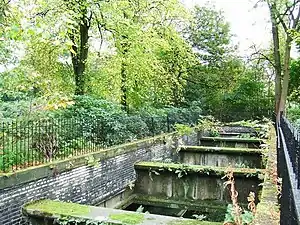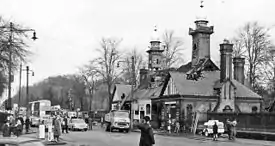Botanic Gardens railway station
Botanic Gardens railway station was a railway station serving the Botanic Gardens located in the Kelvinside area in the West End of Glasgow.
Botanic Gardens | |
|---|---|
 Botanic Gardens railway station in 2007 | |
| Location | Kelvinside, Glasgow Scotland |
| Coordinates | 55.87918°N 4.29129°W |
| Platforms | 2 |
| Other information | |
| Status | Disused |
| History | |
| Original company | Glasgow Central Railway |
| Pre-grouping | Caledonian Railway |
| Key dates | |
| 10 August 1896 | Opened[1] |
| 1 January 1917 | Closed[1] |
| 2 March 1919 | Re-opened[1] |
| 6 February 1939 | Closed[1] |
| 5 October 1964 | Line closed |
| 22 March 1970 | Station building destroyed by fire |

History
The station was opened on 10 August 1896 by the Glasgow Central Railway.[1] The station building was on ground level, and the platforms were underground, beneath the Glasgow Botanic Gardens. It was closed between 1 January 1917 and 2 March 1919 due to wartime economy,[1] and closed permanently to passengers on 6 February 1939,[1] with the line being closed on 5 October 1964.
| Preceding station | Historical railways | Following station | ||
|---|---|---|---|---|
| Kelvinbridge | Caledonian Railway Glasgow Central Railway |
Kirklee | ||
Architecture
The station building was an ornate red brick structure with two towers sporting a clock and Caledonian Railway monogram, topped by domes reminiscent of a Russian orthodox church. The extant, but disused, station building at Possil is of a similar design. It was a well-known landmark along Great Western Road and was designed by the renowned Glasgow railway architect of the period, James Miller.[2]
Miller also designed the next station on the line at Kelvinbridge and went on to design the main buildings for the 1901 Glasgow International Exhibition in nearby Kelvingrove Park and the interiors of the famous Clyde-built ocean liners, the RMS Lusitania in 1907 and RMS Aquitania in 1914.
Use following closure
The building was converted into shops after the station's 1939 closure and by the late 1960s was occupied by a popular café called 'The Silver Slipper', a nightclub called 'Sgt. Peppers' and a plumbers shop, 'Morton's'. It was ravaged by fire on the night of 22 March 1970.[3][4]
Destruction by fire
Local Glasgow newspapers, the Evening Times and the Evening Citizen, of 23 March 1970 stated the fire started after a 'Battle of the Bands' contest had been held in the nightclub and it was likely someone had left a cigarette burning in the attic as it was primarily the roof space that had burned resulting in the decision of the Fire Brigade to pull down the two domed towers for safety reasons the following day. The cafe owner's German Shepherd dog died of smoke inhalation but no humans were injured.
Despite the outer walls of the building remaining intact and the damage confined largely to the roof area, the decision was taken by the then Glasgow Corporation not to undertake repairs and instead to completely demolish the building. At the time of the fire, plans were being considered to demolish the building as part of a controversial scheme to widen Great Western Road and this might lie behind the decision not to repair the building despite its prominent and recognisable presence in the West End for seventy-four years and its housing of three viable local businesses.[2]
Today
The site of Botanic Gardens Station remains derelict to this day, fifty years after the fire. The platforms still remain underground where they can be seen from above through still open air vents in the Botanic Gardens, and the floor of the building is still visible within the fenced-off section of the gardens marking where it stood. The platforms are accessible via the tunnel portal at the Kirklee end of the Gardens. An abandoned tramway kiosk designed in the same style as the building and built in 1903 is still present at the site. The site is heavily overgrown, vandalised and dilapidated and is considered dangerous to enter.[5]
Redevelopment
In September 2007, it was reported plans were under consideration to redevelop the site as a Bar/Restaurant/Nightclub/Exhibition Space and miniature railway which would involve completely rebuilding the station building to its original design on its footprint. The plans were met with considerable opposition from local people who organised a campaign group largely objecting to the idea of a nightclub appearing in a tranquil place like the Gardens.[6]
It was reported on 17 April 2008 that the campaign against the plans had been successful and Glasgow City Council had abandoned the plans. There are no current plans to redevelop the site.[7]
References
Notes
- Butt, page 40
- Worsdall (1981), "Botanic Gardens Station, 740 Great Western Road". Page 142.
- "Archived copy". Archived from the original on 13 May 2015. Retrieved 1 June 2015.CS1 maint: archived copy as title (link)
- "Archived copy". Archived from the original on 29 October 2015. Retrieved 1 June 2015.CS1 maint: archived copy as title (link)
- Urquhart, Chapter on West End Railways
- "Botanic gardens plans get green light". Retrieved 4 November 2007.
- "Botanics nightclub plans scrapped". BBC News. 17 April 2008. Archived from the original on 21 April 2008. Retrieved 2 May 2008.
Sources
- Butt, R. V. J. (1995). The Directory of Railway Stations: details every public and private passenger station, halt, platform and stopping place, past and present (1st ed.). Sparkford: Patrick Stephens Ltd. ISBN 978-1-85260-508-7. OCLC 60251199.
- Urquhart, Gordon R. (2000). Along Great Western Road: An Illustrated History of Glasgow's West End. Stenlake Publishing. ISBN 1-84033-115-1.
- Worsdall, Frank (1981), The City That Disappeared: Glasgow's Demolished Architecture. Glasgow: Richard Drew Publishing. ISBN 0-904002-69-1.
External links
- Video of the station April 2011
- Postcard depicting station building in 1906.
- Botanic Gardens at Hidden Glasgow
- RAILSCOT pictures on platforms
- "Botanic Gardens Station, 7 Oct 2007". Retrieved 28 December 2010.